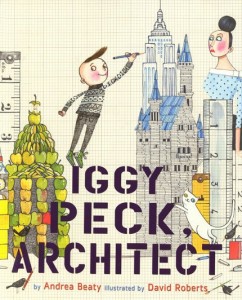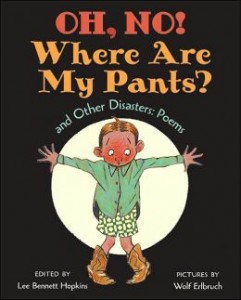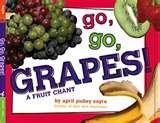Iggy Peck, Architect
 Long have I loved Andrea Beaty’s picture book series about a bear named Ted (grab Doctor Ted, Firefighter Ted, and Artist Ted from your local library and prepare to be charmed.) Then, I saw sitting on the shelf by the Ted books this gem, just waiting to tie in perfectly with science, math, and phonological awareness lessons.
Long have I loved Andrea Beaty’s picture book series about a bear named Ted (grab Doctor Ted, Firefighter Ted, and Artist Ted from your local library and prepare to be charmed.) Then, I saw sitting on the shelf by the Ted books this gem, just waiting to tie in perfectly with science, math, and phonological awareness lessons.
Iggy Peck, Architect written by Andrea Beaty and illustrated by David Roberts will grab young readers on page 1:
“Young Iggy Peck is an architect
and has been since he was two,
when he built a great tower – in only an hour –
with nothing but diapers and glue.”
The story about a young boy who loves to build and saves the day with his architectural skills is told in fantastic rhyme. (Hello, Common Core Standard of Phonological Awareness!) But the beauty of this book is that after you’ve used it in reading lesson, it inspires all kinds of science, art, and math extensions.
When his class is stranded on a small island, Iggy teaches his classmates how to construct a suspension bridge from “boots, tree roots and strings, fruit roll-ups and things”. After sharing Iggy Peck, Architect, pull out Bridges by Seymour Simon to learn more about suspension bridges and how they work (and pat yourself on the back for Integrating Knowledge and Ideas, you Core Standard wizard.) You may choose to forgo tree roots and boots, but challenge your students to plan and construct a suspension bridge, perhaps between two tables, with materials like string, paper, straws, etc. Students can use graph paper like David Roberts did when they draw up their plans, measuring actual distances and then scaling the distances down on paper before they build. Your students will be measuring, counting, drawing, predicting, and revising as they work. Keep architecture books like Bridges! Amazing Structures to Design, Build, and Test by Carol A. Johmann and Elizabeth J. Rieth, or the wonderful David Macaulay books on hand for those inspired by Iggy Peck. As Miss Lila Greer, the teacher in Iggy Peck, Architect realizes:
“There are worse things to do when you’re in grade two
than to spend your time building a dream.”
For more information about the author, go to andreabeaty.com.
For more information about the illustrator, go to davidrobertsillustration.com.
Read MoreOh, No! Where Are My Pants? and Other Disasters: Poems
 Poetry doesn’t have to be “roses are red, violets are blue…” As David Lubar wrote in his young adult novel, Sleeping Freshmen Never Lie, “There are as many types of poems as there are types of food. As many flavors, you might say. To claim you don’t like poetry because you hate ‘mushy stuff’ or things you don’t immediately understand is like saying you hate food because you don’t like asparagus.”
Poetry doesn’t have to be “roses are red, violets are blue…” As David Lubar wrote in his young adult novel, Sleeping Freshmen Never Lie, “There are as many types of poems as there are types of food. As many flavors, you might say. To claim you don’t like poetry because you hate ‘mushy stuff’ or things you don’t immediately understand is like saying you hate food because you don’t like asparagus.”
April is National Poetry Month, but don’t relegate poems to just one month – share all kinds of poetry all year long! (If you do, you can check Range of Reading off your Common Core Standards list!) One of my go-to poetry books is Oh, No! Where Are My Pants? and Other Disasters: Poems edited by Lee Bennett Hopkins with pictures by Wolf Erlbruch. These “disaster” poems range from funny to poignant, and your kids will find at least one to which they can totally relate.
For example, here’s one titled “Oh, No!” by Katie McAllaster Weaver:
“Hello apple!
Shiny red.
CHOMP. CHOMP.
Hello worm.
Where’s your head?”
and here’s part of one called “My Friend is Gone” by Lillian M. Fisher:
“A hug, a tear, and you are gone.
Your swing is missing from the lawn.
Your house is silent, dark and lone.
Your window says no one is home.”
Poetry is meant to be read aloud, so read Oh, No! Where Are My Pants? and Other Disasters: Poems to your class and then choose one or two of your favorite poems to read aloud again. Talk with your students about why you liked that particular poem. Encourage your students either to choose a poem to practice reading or to write a disaster poem of their own. Then, have a disaster poetry slam where you and each of your students read a poem aloud expressively to the class. You can bring a stool for kids to sit on, and a beret to wear, and students can snap for each other instead of clap (I like to teach them phrases like “cool cat” and groovy, man” because it makes me giggle.) Your students will build their reading fluency (another Common Core Standard checked off!) and find that poetry isn’t just mushy love stuff.
Read More
Max’s Castle
 Let me make it easier for you this holiday season, because I know how it is. You want to buy a book for a child for the holidays, but you think they’d probably like a toy better, but you don’t want to give plastic junk, and yet do kids even like educational toys? Do you give the kid an abacus and watch that smile dissolve, or do you give in and buy a lead-coated choking hazard that promotes violence and unhealthy body images?
Let me make it easier for you this holiday season, because I know how it is. You want to buy a book for a child for the holidays, but you think they’d probably like a toy better, but you don’t want to give plastic junk, and yet do kids even like educational toys? Do you give the kid an abacus and watch that smile dissolve, or do you give in and buy a lead-coated choking hazard that promotes violence and unhealthy body images?
Get Max’s Castle written by Kate Banks and illustrated by Boris Kulikov along with wooden letter blocks, a game of Scrabble, or Bananagrams and everyone’s happy! If you have an iPad, tech it up for free by downloading the free Magnetic Letters app to play along while you read!
Max’s Castle is full of imagination and creative problem-solving, along with letter recognition and spelling. I love the way Banks and Kulikov show that switching a few letters changes words. Max and his brothers use alphabet blocks to build a castle. Kulikov does a fantastic job with letter arrangement: Max is in the MOAT hanging onto a block that is angled with an M and a B when Benjamin says they need a BOAT. The boys use the letter blocks to solve problems, like when the ADDER that is literally “in” the DARK DUNGEON (Banks capitalizes the words the boys have built with blocks) is causing problems, the boys take the L from the BUGLE to make the ADDER a LADDER.
Once you share Max’s Castle with that lucky kid or with your lucky students, give the kids letter blocks or Scrabble tiles or the iPad with the Magnetic Letters app to play with and rearrange! You can let students explore independently, or give challenges, like “Here comes a SNAKE ready to attack – what could you make to solve the problem?” Kids can switch out letters to make a RAKE to shoo away the snake, or TAKE it to the woods, or give it a SNACK to eat instead of eating you, etc. Encourage students to see if they can make the word look a bit like the object it represents, like Kulikov did, or use the blocks or tiles to build a structure like Max and his brothers did. Kids will build upon the Common Core State Standards of Print Concepts, Phonological Awareness, and Phonics and Word Recognition while they build fine motor skills. You’ll be the hero of the holidays!
Read MoreGo, Go, Grapes!
 Hip, hip, hooray for April Pulley Sayre and Go, Go, Grapes! A Fruit Chant! How do you make healthy eating fun? With Sayre’s vibrant photos of fruits taken at her local farmer’s market paired with her contagious rhymes:
Hip, hip, hooray for April Pulley Sayre and Go, Go, Grapes! A Fruit Chant! How do you make healthy eating fun? With Sayre’s vibrant photos of fruits taken at her local farmer’s market paired with her contagious rhymes:
“Nectarines, tangerines,
hit the spot.
Glum? Go plum.
Or apricot!”
Start your lesson by asking students, “What do you think a mangosteen is? Or a pomegranate?” Read Go, Go Grapes! and see if your kids can discover what those uncommon words mean. Reread the book and encourage kids to chime in (“Fruit is fun!”) Next, play “Cross the Line”: have all the kids stand on one side of the classroom and imagine an invisible line down the middle of the room – or put down tape if your maintenance team won’t go bananas. Say “Cross the line if you’ve tried kiwi,” and go through the fruits listed in the book. If you have time and funds, bring in some fruits for kids to try! (Check for fruit allergies first – some kids are allergic to certain berries.) Take photos of the fruits and have kids use those Logic Smarts to sort the photos – by color, or by which they liked and which they didn’t. With all the gorgeous colors of fresh produce, you can make a “color wheel” using fruits – challenge kids to eat a rainbow! Go, Go, Grapes, hooray for healthy eating, and super job, Ms. Sayre!
For more information, visit aprilsayre.com.
Read More






